|


Best viewed using


buy, Philip
phone, card, cards,
phonecard, phonecards, sell, sale, sales, cheapest, call, free, hello, asia,
disabled, wheelchair, help, hearing, deaf, Villahermosa, Cebu, Talisay, Lawa-an,
Philippines, Tabunok, support, impaired, Michael, Lorena, St., Saint, Louis,
Missouri, charity, non, for, profit, Filipna, Filipno, deaf, school, philippine,
schools, children, kid, kids, adults, schooling, supplies, philippine deaf,
philippine school, deaf school, donate, used, hearing, aid, aids, fund, loss,
donation, donations, Filipino, PI, Cebu, help, children, kids, impaired,
disabled, hear, sign language, PI, disability, help, helping, community,
impaired, give
| |
|

[ John-John ] [ Hearing Loss ] [
Tour Cebu, PI ]
[ Types of Loss ] [ 4
basic types ] [ How they Work ] [ 10 Myths ] [
Glossary ]
The 4 basic types of hearing aids...
There are four basic types of hearing aids common to most manufacturers. All
four will help with mild to moderate losses, but if loss is more severe, choices
can be more limited. While size is the most obvious difference, each style has
different attributes that are important to consider.
Hearing aids worn behind-the-ear or in-the-ear can carry more sophisticated
technology and more powerful amplifiers; they are also more durable. In
contrast, new smaller models reside closer to the eardrum, and that proximity to
the inner ear can help deliver a more natural sound quality. Your hearing
professional will provide you with a recommendation and rationale thatís based
on your specific needs and physiology.
|
Behind-the-ear (BTE) aids have a plastic housing for the components which rests behind
the ear. A clear plastic tube funnels amplified sound into an earmold in
the ear canal. This model, though developed decades ago, can be every
bit as sophisticated as smaller hearing aids. In fact, it can hold more
circuitry and amplify sounds to a greater degree than in-the-ear types.
BTE aids can be more durable than other types and a few are even
waterproof.
|
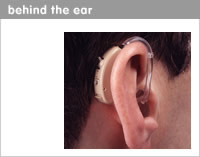
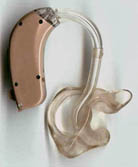
|
|
 |
|
In-the-ear (ITE) aids house componentry in a custom-formed earmold that fits within
the outer portion of the ear. Its size and easy-to-use controls also may
be helpful for those with limited manual dexterity.
|
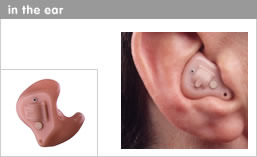 |
|
 |
|
In-the-canal
(ITC) aids are smaller still, with an earmold that fits down into the
ear canal, and a smaller portion facing out into the outer ear. They are
discreet, yet still visible within the outer ear.
|
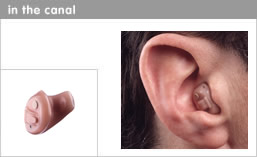 |
|
 |
|
The
newest generation of hearing aids are those that fit completely in the
canal (CIC). Barely visibleóand then only if someoneís peering into
your earóthe only clue to their existence is the head of a tiny
plastic line with which you place or remove the aid. CICs are popular
for their aesthetic appeal, but the physiology of some individualsí
ears (i.e., a very narrow canal) may make this style unsuitable for
them.
|
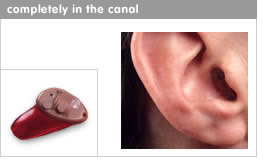 |
|
|
|
|
New technologies
Hearing aid technology has come a long way in the last few years,
thanks to the computer microchip and digital circuitry. Here are some of
the latest innovations.
Digital technology
Why does music from a cd sound more crisp, clear, and distortion-free
than music from a record or tape? The answer, at least in part, is the
difference between analog and digital sound processing.
Digital hearing aids have one or more microchip processors inside them
that convert analog sound waves into the zeros and ones of computer
language. Sound in this format can be processed more quickly and more
efficiently than analog sound waves; in fact, incoming sounds are sampled
at a rate of a million or more times per second. The digital aidís
circuitry analyzes these sound levels and frequencies, manipulating them
to provide a more efficient match to an individualís hearing profile.
For example, a person with hearing loss may have trouble hearing soft
sounds, but when some sounds are amplified even a small amount, they
become uncomfortably loud. Hearing aids with digital compression circuitry
are able to stratify incoming sounds, detect those that need amplification
from those that donít, and process the sound accordingly.
Programmable technology
Digitally programmable hearing aids, which are different from fully
digital aids in that theyíre not equipped to process all incoming sound
digitally, offer the very useful benefit of being able to sculpt sound to
fit a particular individualís unique hearing profile, and can be
reprogrammed if there are changes in hearing loss. Programmable aids can
be set up with multiple channels, enabling you to preset and store several
different programs, each sculpted to a particular set of sound
environments. You can then select the appropriate program using a button
or remote control unit: normal conversation, concert hall, office, or
telephone, for example.
Feedback reduction technology
Feedback has long been a problem for hearing aid wearers. Now we know
a lot more about feedback, and have developed ways to deal with it.
Feedback happens when amplified sound waves escape back out through the
ear canal and are then re-amplified by the hearing aidóresulting in the
high-pitched squeals that set your teeth on edge. Smaller, in-the-canal
styles of hearing aids place components closer to the eardrum, preventing
sound waves from escaping, thereby reducing, and often eliminating,
feedback. Some new aids are also able to detect these sounds before they
become audible and cancel them out, greatly reducing this frustrating
problem.
How hearing aids are made
Hearing aids are not a standardized product; each aid has elements,
including the shell or earmold, that are custom-made for the wearer. If
you decide to try a hearing aid, the steps are quite simple. After the
testing process, your hearing professional will make an impression of your
ear, a relatively easy process.
A bit of cotton or foam is placed well into the ear canal to block any
of the impression material from reaching the eardrum. Then the malleable
impression material is placed in the ear until it sets, which takes a few
minutes. Once it has conformed to the shape of your ear, itís gently
removed.
This impression or mold of your ear is sent, along with your audiogram
and other test results, to the manufacturerís lab. Hearing aids are
individually constructed, beginning with the plastic housing or earmold,
an exact replica of your ear impression. Circuitry is added, the aid is
tested, and then shipped back to your hearing professional.
When the finished hearing aid is sent back, youíll see your hearing
professional for the fitting. This is likely to include repeating some of
the audio testing you underwent initially, as well as tests that measure
the hearing aidís performance. As your hearing aid is fine-tuned, itís
a good time to ask questions, and talk through initial expectations with
your hearing professional. You may need to come back a time or two for
further adjusting, which is typical and usually covered in the purchase
price of most hearing aids.
Provided by Starkey Labs
|

|
|